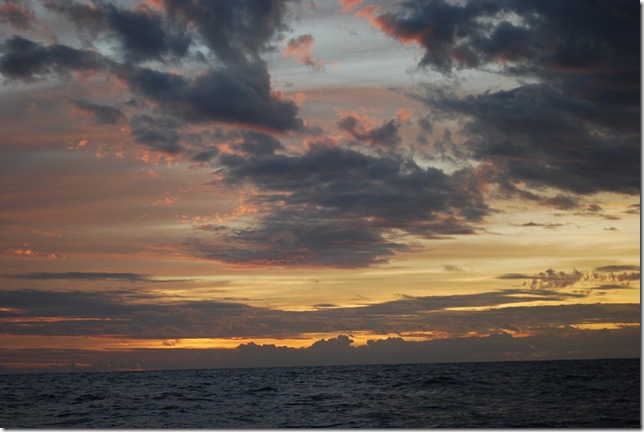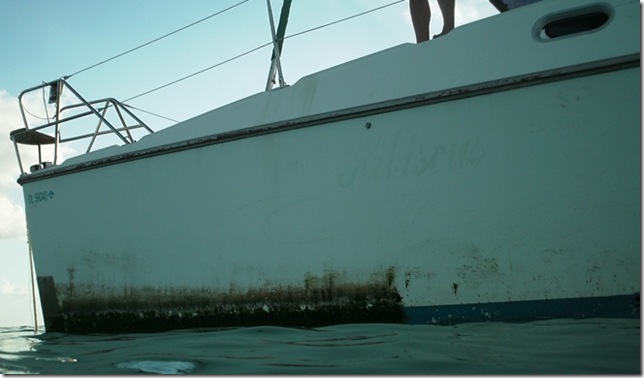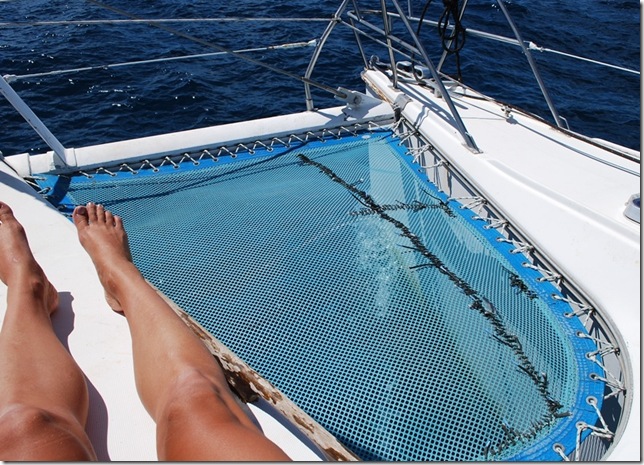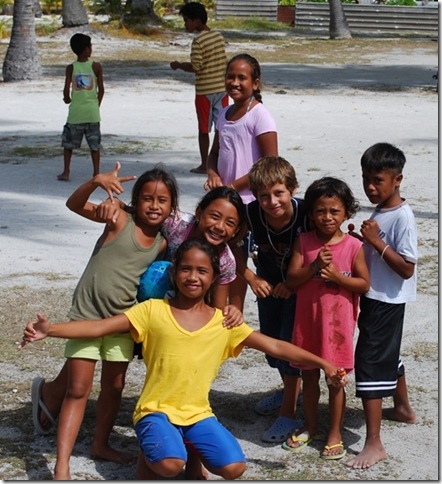Lat: 17 17.277′ S
Lon: 149 06.195′ W
Antoine had warned us that the "bombies" (Australian for coral heads) were bad where we had anchored in Fakarava and that we shouldn’t be surprised if we had trouble getting our anchor and chain up, as it may be wrapped around or stuck underneath a coral head. I’ve seen a windlass get pulled right out of a wooden deck by a captain who had his anchor chain wrapped around a coral head and tried to use the force of the swell to break it loose (thinking is was just stuck in the mud). When push comes to shove between a coral head the size of a van, ocean swell, and some part of a boat, the boat generally doesn’t fare well. Our chain was indeed stuck on a coral head, but the wind had only shifted slightly to the north while we had been anchored, so we let some more chain out, motored to the north to try to undo the effect of swinging south, and as they say here, "Voila!" In the process of anchoring I also discovered why our windlass has been so weak — the clutch needed to be tighter. There’s a manual clutch that you turn like a screw to engage or disengage the windlass motor from the gypsy (turning wheel the chain runs through). By using a wrench to tighten it instead of my hand, it was able to pull much harder without slipping, and I didn’t have to pull any of the chain or anchor up by hand at all!
Here I have to make a short digression to share a funny windlass story that Antoine told me. He had called us on the radio one night but couldn’t hear our response (cheap West Marine Radio), so I dinghied over to see what was up. He just wanted to know how our passage to Fakarava had been, but I stayed and chatted for a while. He mentioned that he was having trouble with his windlass and needed a part, but the windlass and spares were no longer in production. Since our boats were both designed and built in France within a year of each other by like-minded architects, I asked him was model of windlass he had. It turns out that it was the same windlass that was previously installed on our boat but was replaced by the previous owner (and probably just had a wiring problem). It was still in a locker when we bought it, so I’d sold it to a second-hand sailing store in St. Augustine, FL. I would be surprised if they’ve sold it, so maybe he’ll be able to contact them and buy the part he needs. (He’s been trying in vain to find the part in France.) If that wasn’t coincidence enough, he told me the story of replacing a certain part on the same windlass several years ago. After four or five years, the part had gone bad again, but now the windlass was out of production. He was trying to get by for a while and thinking about what to do when he was walking on an atoll in the Tuamotus and saw the very part he needed lying around! It was being used by a guy who sold diesel to prop up some piece of equipment. Antoine explained to the man that it was anything but scrap metal to him at the moment, and the guy told him to take it. After inspecting it more closely, he realized that it was the old part from his own windlass that he had left on the atoll years before when he got the replacement part. Although it wasn’t in perfect condition, it was now better than the "new" part, and he’s still using it in his windlass today.
Before leaving, I tried a new showering method. We’ve had several people tell us that you can enjoy a great "shower" by just jumping in the ocean naked, then toweling or rinsing off. As this seems to be the method practiced by the Swiss boat anchored in front of us, and the anchorage only had a few very salty residents, I gave it a shot. It’s definitely my favorite method so far. It’s very refreshing, and shampooing your hair with both hands while you’re treading water makes for pretty good exercise. The downside is that Irish Spring doesn’t really lather well in salt water.
We had great wind from the NE when we pulled the anchor up, so we were able to sail from the anchorage, through the pass, and then on a heading for Tahiti. Even though the north pass in Fakarava is the widest in the Tuamotus (1.5 km), the current was still strong enough that we almost had to turn on the engines to avoid being swept onto the west side of the pass. The tide was coming in, and our speed was slowed so much by the current that our leeway (wind in the sails pushing the boat sideways) and the swell was slowly pushing us from the east side of the pass to the west.
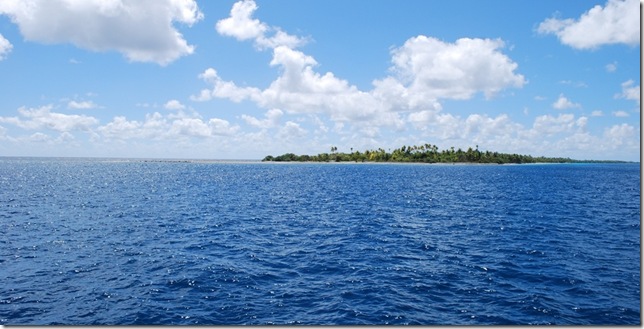 Sailing through widest pass in the Tuamotus
Sailing through widest pass in the Tuamotus
The passage itself has been pretty uneventful. We ended up motoring the first night because the winds were too light to keep the sails set. We’re almost 2 knots faster under power after cleaning the bottom and props, so that does make the hours of work seem more worthwhile. In the morning, we set the green spinnaker, and it’s been up ever since. We’ve had a lot of hours with an average speed between 2 and 3 knots, but the wind picked up this morning and we’re doing a very easy 6+ knots and are only 25 nm from Point Venus, where Captain Cook observed the transit of Venus, the official purpose of of one of his circumnavigations (simultaneous measurements of the eclipse were intended to allow a calculation of the circumference of the earth).
We have had some cool fauna sightings. Friday night, when I went out to make a 15-minute check, I saw a bunch of glowing blobs in the water and called Lauren out on deck. We were motoring through large schools of glowing jellyfish that were between volleyball and soccer ball size. We motored through several of the schools over the next 15 minutes, which was a really cool sight. The water is so clear out there that it’s hard to tell how far down they were, but they seemed to be within 1-6 feet of the surface.
As I was near the stern preparing to set the spinnaker just before dawn Saturday, I heard the unmistakable sound of breaching. I turned around and saw a large dolphin or small whale, about 12-15 feet long, break the surface to exhale a couple of times. It was only about 15-20 feet from the stern, but in the pre-dawn twilight, I couldn’t make out enough color or detail to tell what it was.
Yesterday morning, one of the large flocks of fishing birds came close to the boat. We see them fairly frequently, but this time, there were large fish, about 2 feet long, jumping out of the water below them. Apparently the large school of fish was being hunted from below and above at the same time.
Yesterday the temperature in the salon reached a record 89 degrees, which was a little warm, although when it got down to 80 degrees in the evening with a light breeze, I was cold enough that I had to put on a T-shirt. We were talking today about how the passage to New Zealand is going to be such a climate shock for us. I’m sure we’ll be searching for pants and sweaters when the temperature drops below 75.
Odds and Ends
Here’s a collection of miscellaneous observations about the Marquesas and Tuamotus that didn’t make it into previous blogs, but that we found interesting.
On every island and atoll there was a concrete recreation area with a basketball goal at each end. With possibly one exception, all of the basketball goals had the hoops (not just the nets) missing. I’m not sure what master plan saw the people of French Polynesia taking up basketball, but it never caught on. Volleyball is popular here (as it was in the Galapagos) and soccer is played on the concrete areas as well, but bocce ball seems to be the most common game, especially among the adults.
Finding a toilet (especially a public one) with both toilet paper and a toilet seat is a somewhat rare occurrence. Many cruisers carry toilet paper in a ziploc bag as a permanent part of their shore bag. Another interesting restroom feature that’s not uncommon is a lack of running water. In this case, there is usually a large barrel of water nearby and you simply carry small buckets of it to the toilet to fill the tank before or after you flush.
It’s not unusual for Polynesians to have visited the US. They hold French passports, and because of the nuclear testing that occurred in the Tuamotus, salaries were fairly high, and the French have consented to maintain a significant flow of cash into Polynesia now that the nuclear testing has stopped. Hawaii, Los Angeles, Las Vegas, and New York seem to be popular destinations.
We’ve already mentioned that pigs and chickens are often kept in the yard. Roosters are sometimes tied by the leg to a tree, pigs are usually tied by the leg, and many hens and roosters wander free. Of course if you have a pig in the yard, it’s so that someday it ends up on the table, and Lauren and I both heard the sound of a pig being killed for slaughter the day before the bishop came to Kauehi. I was walking back to the boat while she was walking to the store, but it was one of the first things we brought it up the next time we saw each other. It’s a sound you instantly recognize but never hear in the US no matter how many bacon cheeseburgers you eat.
When we were talking with Jimmy on Kauehi, he said “Obama, Yes We Can” several times. It’s really hard to appreciate the widespread influence of US pop culture and politics until you come to the middle of the ocean and find that people here really care about the US president and the death of Michael Jackson. It reminded us of visiting Bermuda in November last year, where hand-painted Obama signs were a common sight. We overheard a local telling a story about the scene in Bermuda on election night in the US. Apparently a couple of the bars in the main town were full of people watching the returns, and when the result was announced, people from a bar frequented primarily by white Europeans & Americans ran out into the street where they found the people from another bar down the street frequented primarily by black locals also rushing out. The two groups stopped and looked at each other then ran toward each other. When the groups met in the middle of the street, there were high fives and cheers all around. To me, the amazing thing is that no matter what your preference is in terms of the train of Republicans and Democrats that fill the oval office, someone on a small island in the middle of the ocean is more passionate about the US President than many US citizens are. It’s also an almost certain guarantee that a local will really like at least one well-known US singer (though their taste can be entertaining).
An interesting thing seems to happen when someone from a modern Western culture becomes an ex-pat and is deprived of the opportunity to speak with people that either speak English or share the same cultural background and general news interests. They become ravenous for conversation with English speakers with a similar perspective. There was an Australian guy on Ua Pou that was married to a local and was the only native English speaker we met in the Marquesas. He was in his 70’s and was almost impossible to end a conversation with unless you just walked out of sight. Lauren and I met someone similar in Jamaica, a Canadian who had retired in “paradise”, but even with English as a local language, he was starved for conversation with a North American. With my French being pretty rudimentary, I was surprised at how excited I got when we met a someone who spoke Spanish as well. Although it’s possible to get around and take care of necessities without a common background and very little common language, it’s really nice to talk to someone with whom these are shared.
The feet of people who go barefoot for a lifetime are very large, especially wide, and calloused. It’s hard to imagine them ever fitting into shoes. Some of the old men in the procession at Kauehi were barefoot or wearing only flip-flops. English speakers call this route through the Pacific “the (coconut) milk run” but the Germans call it “the barefoot route.” It’s easy to identify the ones that have actually lived the barefoot life.
We’re leaving for Tahiti this morning. According to the weather forecast, we should expect pretty light winds, so the 250 miles or so could take 3 days. With oil and gasoline at a premium here, we’re trying to limit engine time, so hopefully there will be enough wind to keep the sails set.
With a light wind passage ahead and beautiful lagoon water underneath the boat, Lauren and I decided to do boat work yesterday instead of dive the south pass. Unfortunately, the dive trip was an all-day 2-dive package that was 3 times what it cost us to dive the north pass, so Wes and Tiff decided to pass it up as well. We had gotten up at 6 am to get over to the dive shop, so Lauren and I were in the water pretty early to finish cleaning the bottom of the boat. Since it had not been cleaned since the Galapagos, it had become a pretty big job. We’d already put in several hours work, and it still took both of us working for over 2 hours to finish it off. The algae/weed on the outsides of the hulls, which get more sunlight, looked like green shag carpeting 1-2 inches long! There were plenty of barnacles on the bottoms of the keels and hulls as well. As we scraped the barnacles off, two schools of fish about a foot long swam 10-20 feet below us and munched on the small barnacles that were floating down like confetti. One school of fish was silver with yellow markings and the other was silver with long, thin snouts and well-defined mouths and eyes that really made them look like they had an animal face. We changed the sacrificial zincs on the prop shafts as well (about 4 months old), so hopefully we’ll be OK below the waterline for a while, although in the future I think we’ll opt for lighter and more frequent cleanings instead of waiting so long. Two 12-meter hulls make for a lot of surface area to scrub by hand, especially underwater.
It was interesting to note that the area of the starboard keel that Wes repaired in Key West had virtually no marine growth at all on it. We went with el cheapo $60/gal bottom paint in January but bought a quart of expensive stuff to cover the patched area because it was all we could find in the same color (and fish hate looking at a two-color paint job). It looks like we got what we paid for. The $60/gal stuff is great as long as you don’t keep your boat in the water, let alone the Humboldt current and South Pacific.
We spent the rest of the daylight re-running the main halyard inside the mast, doing laundry, fixing the port navigation light, which had gone out again on our way to Fakarava (more corrosion), and stitching up the starboard tramp again. The starboard tramp now has quite a bit of stitching, but hopefully it will at least get us to New Zealand. Wes also ran a new roller furling line, which had chafed through the outer jacket in several spots and repositioned the high water bilge alarms that had gone off while we were drifting in the swell.
Running a new in-mast halyard turned out to be an adventure. The winning solution ended up being a thin messenger string with several bolts tied one after the other at the end (one large bolt got stuck and one small bolt was too light). After several failed attempts, I was finally able to lower the string down from the top of the mast and fish it out of the tiny hole at the bottom with a coat hanger. Lauren is developing some nice biceps winching me up the stick while I try to figure out how to get the job done. Our main halyard is now about 100′ of 1/2" Sta-set with about 3′ of 1/4" stainless steel wire spliced into the end. The middle of the halyard had chafed badly where it exits the mast and rubs against a turnbuckle, so I tried repairing that spot with waxed twine (used for whipping the ends of lines) and covering the turnbuckle threads with plastic hose and rigging tape. We’ll see how it all works out this time. When I mentioned the halyard problems to Barry in Daniel’s Bay, his response was, "Yeah. After a while you’ll start dropping the sails every day or two to check them." That sounds like a good idea.
The wind has been very light and we’re tucked in close to shore, so things at the top of the mast weren’t near as lively as before. I spotted a sea turtle on my way up the first time. He was swimming right toward the boat, but I think my hollering down to Lauren to point him out scared him, as he disappeared into the turquoise water before he got much closer. I should have take a camera up, because the view of the lagoon, with all the coral heads in the clear water close to shore, was really incredible. Going up the stick is generally more uncomfortable than dangerous, but I always hold on to the shrouds on my way up and have a safety line or tether rigged just in case. Today I was reminded again how important the safety line could be. Because of the halyard work we were doing, I went up on the spinnaker halyard, which is sort of a compromise. The line is in really good shape, but it runs through a block attached to the outside of the mast with a shackle, which adds a couple of failure points I’d prefer to avoid. When I got to the top of the mast, I noticed that the shackle holding the block, which is about 3/8" stainless, was worn almost half of the way through from rubbing against the eye it’s hanging from. The marine environment definitely keeps us busy.
We’ve really enjoyed the sparsely populated Marquesas and Tuamotus. It’s been long enough since we’ve seen a big city that it will be interesting to see how Tahiti feels to us. Even though this is the second largest atoll and village in the Tuamotus, it’s still pretty small by US standards. There are several hotels and tourist businesses due to the large, easily navigable north pass, but there’s still no bank (there is an ATM in the post office, but it’s only open part of the day), bicycles are as common on the one main street as cars, and the colorful "school bus" takes all the kids home at lunchtime. You know you’ve been away from "civilization" for a while when you get excited about the local store accepting a credit card as payment, having cans of Pringles for only $3.75 each, and being "big, and well-stocked, and cheaper" when the entire store would take up less than one supermarket aisle and a box of pancake mix is $10.
It wasn’t unusual in Kauehi for people to come up to us while we were walking around to say hello and ask us where we were from, trying out whatever English they knew. When Lauren, Wes, and Tiff gave a group of kids some candy, they gathered around as a group to compare their "bon bons" and then one turned and yelled "THANK. YOU." with a big smile. Papeete seems large enough that the anonymity and isolation of city life will be the norm, but we’ll see. Jerome on Na Maka told us that contrary to what people say, the people of the Society Islands are friendly as well, but meeting and making a friend "doesn’t take 30 minutes, it takes 2 days." Antoine says the norm is for the interaction with locals to be replaced by meeting all the other cruisers that linger in the Society Islands. We do know from Antoine’s DVD (another gift) that the Society islands will be incredibly beautiful.
Kids in Kauehi
It has been a while since we posted a blog with a dramatic title since traumatizing several of you with the "Big Seas and Machine Guns" post, but I thought it time to try again. We are using wireless internet to post instead of blogging from sea (using the sat phone as the modem), so you should be able to read the entire blog this time.
The wind finally let up enough to allow us to leave Kauehi on Monday. It was a few days days later than we had planned, but I think it was a good choice. Not only did we get an intimate glimpse into the culture of the atoll during the pilgrimage and worship service on Saturday, but also we were able to avoid a potentially hairy passage to Fakarava.
The scariest parts of the passage are in the passes, the openings between islets of the atoll in which one can pass into or out of the lagoon. These passes are known for their strong currents, as you can imagine given the disparity between the depth and magnitude of the water on the side of the ocean versus that of the lagoon. We managed to get to the Kauehi pass just as the sun was setting so that we could see what we were getting into. There were 3′ breaking waves in the center of the pass, one right after another. Dallas steered around them so that we only just caught the edge of one wave, but even that was enough to literally rock the boat, displacing the few items that weren’t well stowed. It would have been really hairy the day before with the wind howling and the rain pouring.
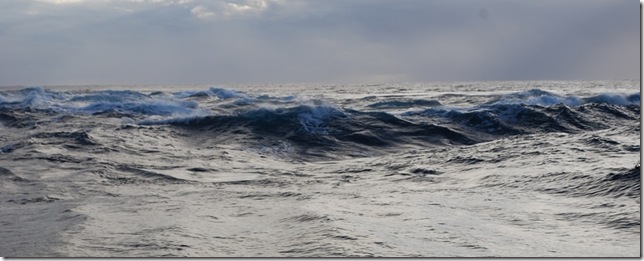 Breakers inside the Kauehi pass
Breakers inside the Kauehi pass
With the wind from behind, we sailed at an average of 5 knots through the night under the jib alone. This was faster than we expected, and since we did not want to arrive at the pass at the north end of the Fakarava atoll before daylight, we ended up spending a couple of hours just drifting without sail or motor to kill some time. This probably sounds very peaceful, but after several days of strong winds, the swell alone created a surprising amount of motion, causing us to take on water in the forward and amidships bilges. Fortunately, the amount of water in the bilges was no cause for concern. Unfortunately (and a bit ironically), the water kept splashing up against the sensors of the high-water bilge alarms that Dallas and I had just finished installing two days before. All four of us can attest to the fact that the alarms are working well, as no one got much sleep that night! (Dallas is now planning to move the sensors up higher in the bilges.) Nevertheless, it was fairly calm in the north pass of Fakarava, the largest pass in all of French Polynesia.
As is typical of us when arriving someplace new, we carried on as if we weren’t exhausted in an effort to explore our new locale. This seemed to be marginally successful. Wes and Tiff visited the village first, and Tiff informed us that as the village was quite a bit larger and more spread out than Kauehi, it would be better to explore by bike. We hadn’t gotten out the folding bikes since we left Florida (the Marquesas were too mountainous for my little one-speed), so I was pleasantly surprised that they weren’t rusted shut, or even rusted at all! Hooray for boats that don’t leak!
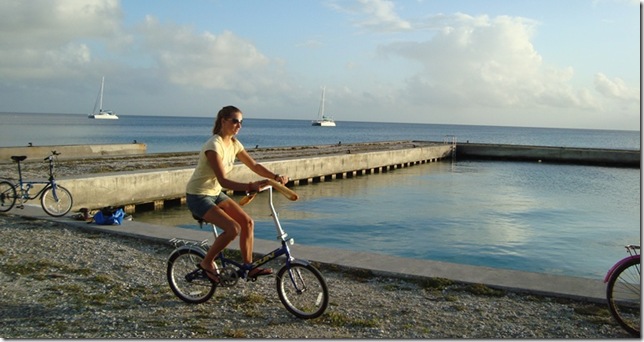 Procuring a baguette via folding bike
Procuring a baguette via folding bike
Fakarava is like Kauehi in many ways such as the beautiful turquoise water of the shallows and the white coral islets that somehow manage to sustain palm and breadfruit trees. However, as it is the "big city" (this is one of four atolls in the Tuamotus that actually has wireless internet!), there is more money changing hands and more to do. We weren’t able to locate the bank before it closed (and since there wasn’t one in Kauehi, we’ve been out of cash for several days now) but found that they accepted credit cards at the local grocery store. After buying a snack (we splurged on a small can of Planters peanuts for $6) and cold Hinano, Dallas and I checked out one of the pearl vendors’ wares and found that we got a really deal on the few that we purchased in Kauehi. A large single pearl on a simple black rope necklace was selling for almost $250. Our last stop was the dive shop. We had been told by the French on Na Maka in Kauehi that while the north pass was a must-see in terms of diving, it was a drift dive (drifting with the current) and too dangerous to do on one’s own. The professionals confirmed this (naturally), so we made plans to join them for a dive of the north pass this morning. In doing so, we found out that our watches were an hour off of local time. This means that the entire time that we spent in Kauehi, we were an hour ahead. No wonder we were always waiting around for people!
We arrived with mask, fins, and wetsuits in hand at 8:00. Other divers kept arriving until ultimately there were about 30. I had never seen so many people in one place for a dive before, so that boded well. The staff appeared to be French as were nearly all of the divers. In fact, it felt a bit more like being in France than in Polynesia, but not in a bad way, as all of the French people we have met here thus far have been extremely nice (and incidentally, extremely thin), evincing a certain joie de vivre that must coming along with getting to live/cruise in one of the nicest places in the world for an unlimited amount of time. Hooray for French colonialism! But I digress…
Our dive master was an animated young Frenchman named Nicolas (NEE-ko-lahs) who explained that we would be dropped off by the boat (a large inflatable with two outboard engines) on the ocean side of the pass at the opportune moment right as the tide began to come in so that we would drift through the schools of fish and sharks as they swam out to sea. He continued to describe that we would drift into an area of coral that they call the "Twin Towers" from which one can look up to see many sharks circling above like planes flying overhead in the King Kong movies. It was amusing to hear the American pop culture references, but I was primarily focused on the SHARK aspect. I think it was at this time that I started to get butterflies in the stomach, a feeling I haven’t had for quite some time. It was with excited anticipation that we arrived at the drop spot (after seeing a large ray and dolphins en route), and then suddenly there was no more time to think about it. It was three-two-one-drop!
As we sank down into the cool water, I was amazed at the clarity of the water. Dallas estimates that the visibility was at least 50′, and I don’t doubt it. We dropped down to about 90′ and could immediately see all kinds of fish, from schools of snapper to large colorful parrotfish. Nicolas motioned for the four of us to follow, and we began drifting into the pass. The current was incredibly strong and initially pushed us off to the side such that I was nearly on top of Tiffany. It was nearly impossible to move in a straight line or to make any very deliberate movements for that matter, but Nicolas demonstrated that we should grab onto the coral at the bottom (typically a no-no) in order to stay put and take in the scenery. The gray sharks began to approach, and we stayed a comfortable distance behind Nicolas until we were convinced that no harm would come to him (or us)! They were pretty large (4-5′) and incredibly sleek as they whipped past us just a couple of arm’s lengths away. By no means did they seem frightened of us (as I had been told they would be), but neither did they seem interested as they just plowed on toward the sea. It happened so fast that there wasn’t time or reason to be frightened of them. It was just surreal.
Also surreal was getting into the middle of the pass so that we were getting pushed by the current in the direction we wanted to go. It felt as if we were astronauts flying through space, and I couldn’t help but do a couple of flips to express my love for the simulated zero-gravity experience. All the while, we could see colorful arrays of fish in all shapes and sizes passing through the mostly red-orange colored coral. One of my favorite sights was a unique type of coral that was soft and flexible and shaped like a collection of thin spindles making up a moving carpet. The underside of the coral really did look like carpet backing, and I was really surprised to find that it felt so squishy.
I could probably go on and on about the experience, but it is probably one of those things you have to see for yourself (if only on the Discovery Channel). I should include, however, that we had some excitement at the end of the dive when Tiffany was running low on air. I had encouraged her (through hand signals) to alert Nicolas earlier in the dive when she had hit the reserve mark, but he waved it off as if it wasn’t too important. Fortunately, he recognized (in his French, laissez-faire kind of way) that this was in fact important, as he called her over several minutes later so that he could pass her his spare regulator to ensure that she could breathe for the remainder of the dive! We (including Tiffany) had such as good time today that we are planning to go with the pros to the south pass of Fakarava tomorrow to get in another dive before taking off to Tahiti. With any luck there will be more sharks and more current!
Tonight we had Antoine of S/V Banana Split over for dinner. Dallas and Wes have seen him each day for the last few, as he followed us here from Kauehi on Tuesday. Tonight he shared some interesting stories from his days of fame, including being in a movie that Andy Warhol made of celebrities eating bananas and having lunch with Salvador Dali. Antoine had some fruits and veggies flown in here from Tahiti and was kind enough to share them with us. Green peppers and starfruit are a luxury belonging only to celebrities (and their friends) out here!
Next stop, Tahiti…
Here are answers to a few questions from Margo and Patsy…
Q: Do you guys experience boat-lag (like jet-lag)?
A: We don’t have a problem with jet lag for a couple of reasons. First, we never cross more than one time zone in a day. In general, timezones are 15 degrees of longitude or approximately 900 miles wide, which is well below our best distance in a day (over 200 nm in one day during our Galapagos-Marquesas crossing). That means that the time doesn’t change by more than one hour at once for us. Second, and probably equally important, we don’t have a fixed schedule that starts with an alarm clock going off at a particular time. We tend to wake up based on the rising sun, and even if we changed our clocks to mark passing into a new timezone, the change in the time of sunrise is pretty small from day-to-day so we adjust slowly.
Q: Dallas wrote about the “signs of mankind” that you all had seen on the water and I wondered about all the plastic we hear so much about. Have you seen any plastic nastiness……water bottles or soda bottle rings etc. floating around?
A: Yes and no. We saw a lot of floating plastic trash in Panama and haven’t seen much here in the Pacific. I think there are two reasons for this. One, there are fewer people out here polluting than there are in North and South America. Second, the floating plastic trash is carried by ocean currents. Since we neared the Galapagos, we’ve been in an area where the current is generally flowing east-to-west over a wide area and not allowing trash to collect. If you Google ocean currents of the world, you’ll see that the large oceans basically have circular current patterns in each hemisphere, with local variations. Because of the currents, some places collect a lot of floating trash and others collect very little. Here in French Polynesia, we’re in a part of the ocean that collects
very little trash, but there are places where the amount of trash is considerable. You can also see from the ocean current pictures that ocean trash is not a local problem. It can come from anywhere and end up almost anywhere. As a side note, ocean currents are also pretty interesting for their extremely important effects on weather and the earth’s overall thermal equilibrium (distributing the energy that comes from the sun).
Q: What does the S/V stand for at the beginning of the name of a boat/ship?
A: My understanding is the S/V stands for Sailing Vessel. M/V is for Motor Vessel.


